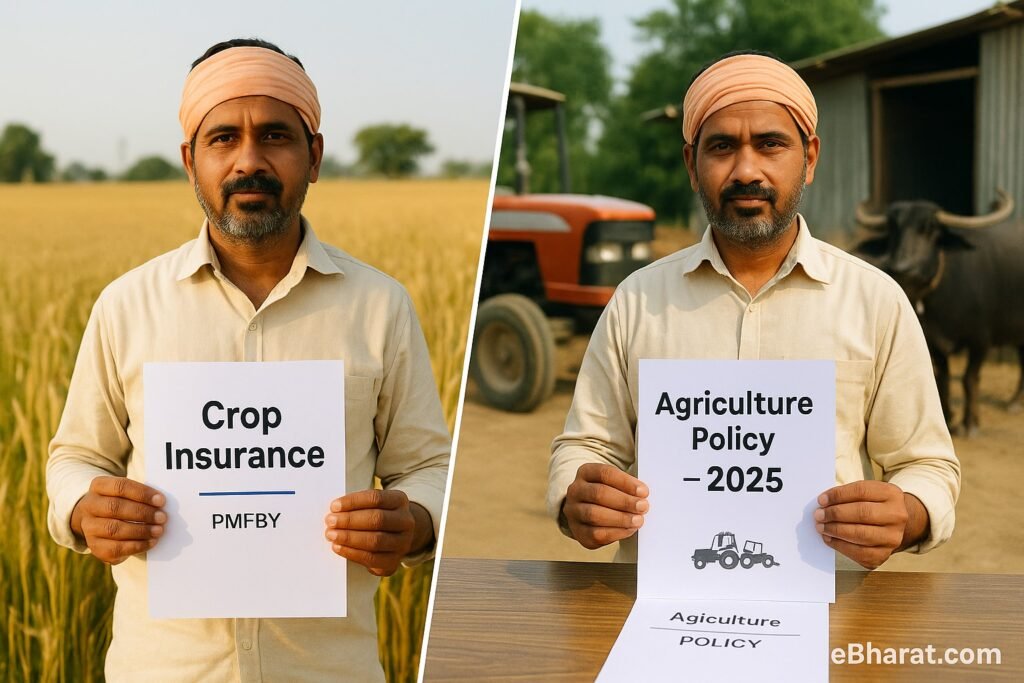
Agriculture remains the backbone of India’s economy, with over 50% of the population dependent on farming. Yet, farmers face huge risks from droughts, floods, pests, and market price fluctuations. To safeguard them, insurance solutions like Crop Insurance and broader Agriculture Policies exist.
In 2025, with climate change and unpredictable weather, it is more important than ever for farmers to understand the difference between these two options.
What Is Crop Insurance?
Crop insurance specifically covers the loss of standing crops due to natural disasters, pests, or diseases.
- Introduced under schemes like PMFBY (Pradhan Mantri Fasal Bima Yojana).
- Premiums are subsidized by the government.
- Coverage includes sowing risks, mid-season damage, and post-harvest losses.
Example: A farmer in Rajasthan loses his wheat crop due to drought. Crop insurance compensates him based on yield shortfall.
What Is an Agriculture Policy?
Agriculture policies are broader insurance products that cover not only crops but also other aspects of farming:
- Farm equipment (tractors, harvesters).
- Livestock (cows, buffalo, poultry).
- Storage units and warehouses.
- Farmer’s personal accident cover.
Example: A dairy farmer in Punjab insures his cattle under an agriculture policy to get compensation if livestock die due to disease.
Key Differences: Crop Insurance vs Agriculture Policy
| Feature | Crop Insurance | Agriculture Policy |
|---|---|---|
| Coverage | Standing crops only | Crops + equipment + livestock + farm structures |
| Premium | Low (govt-subsidized) | Higher, depends on sum insured |
| Risk Focus | Weather, pest, yield loss | Comprehensive farm protection |
| Example | PMFBY scheme for wheat crop | Policy covering tractor + cow + storage |
| Beneficiaries | Small & marginal farmers | Medium & large farmers, agribusiness owners |
Benefits of Each
Crop Insurance
- Affordable (govt subsidy).
- Encourages farmers to take risk and grow.
- Secures rural livelihoods against climate shocks.
Agriculture Policy
- Holistic protection for farm assets.
- Reduces financial burden of equipment/livestock loss.
- Suitable for agribusinesses and commercial farmers.
Government Support in 2025
- PMFBY continues as India’s largest crop insurance program, covering millions of farmers.
- States like Maharashtra and Rajasthan are pushing digital claim settlement via drones and satellite yield estimation.
- IRDAI is encouraging private insurers to innovate in comprehensive agriculture insurance packages.
Case Study: Mixed Coverage
Ravi, a farmer in Haryana, bought crop insurance for wheat under PMFBY. Later, he also took an agriculture policy covering his tractor and two buffaloes. When floods destroyed his crop, he got a payout from crop insurance. A few months later, when his tractor was damaged, the agriculture policy helped him.
This combination ensured his income stability and asset protection.
Why This Matters
In 2025, farmers cannot rely only on traditional crop insurance. With mechanization and livestock becoming vital to farming, agriculture policies are essential for comprehensive security. Choosing the right mix ensures long-term sustainability.
Next, read: Public Liability Insurance: Which Businesses Must Buy It
🚀 Start Your Career as an HDFC Life Agent
Join eBharat’s Agent Network and get training, digital tools, and mentorship to build a successful career in insurance.
👉 Apply Now to Become an Agent












